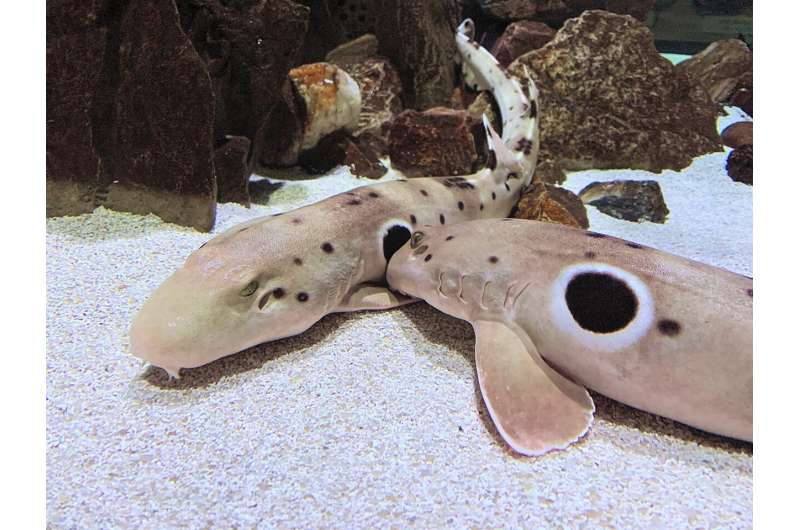Study first to explore 'walking' sharks on the move in early life stages

A newly-discovered walking shark that breaks all of the rules for survival is the focus of a first-of-its-kind study by Florida Atlantic University and collaborators in Australia. Researchers investigated how walking and swimming changes in the epaulette shark's (Hemiscyllium ocellatum) early development. This small (about 3 feet), reef-dwelling, benthic shark walks both in and out of water by wriggling its body and pushing with its paddle-shaped fins.
Found within the reef flats around Australia's southern Great Barrier Reef, epaulette sharks experience short periods of elevated CO2 and hypoxia (low oxygen) as well as fluctuating temperatures as reef flats become isolated with the outgoing tide. Remarkably, this walking shark is capable of surviving complete anoxia (no oxygen) for two hours without adverse effects, and at a much higher temperature than most other hypoxia-tolerant animals.
The epaulette shark's ability to move efficiently among micro-habitats under these challenging environmental conditions could directly impact their survival and physiological responses to climate change. Yet, very few studies have examined their kinematics (body movements). Those that have, only focused on adult-life stages. No study has specifically examined their locomotion (how they move) during early-life stages, until now.
As locomotor performance may be key to the epaulette sharks' robust response to challenging environmental conditions, FAU researchers in collaboration with Australia's James Cook University and Macquaire University examined differences in walking and swimming in neonate (newly-hatched) and juvenile walking sharks.
Neonates retain embryonic nutrition via an internalized yolk sac, which results in a bulging belly. In contrast, juveniles are more slender because they actively forage for worms, crustaceans and small fishes. During development, the yolk that the neonate sharks are storing starts to diminish as they develop into juveniles. As the yolk is depleted, the shark then begins to actively forage.
Because of dissimilarities in body shapes, researchers expected to see differences in locomotor performance in these walking sharks. To test their hypothesis, they examined neonate and juvenile locomotor kinematics during the three aquatic gaits they utilize—slow-to-medium walking, fast-walking and swimming—using 13 anatomical landmarks along the fins, girdles and body midline. They quantified axial body kinematics (velocity, tail beat amplitude and frequency and body curvature) and axial body bending, fin rotation and duty factor and tail kinematics.
Surprisingly, results published in the journal Integrative and Comparative Biology, showed that differences in body shape did not alter kinematics between neonate and juvenile walking sharks. Overall velocity, fin rotation, axial bending and tail beat frequency and amplitude were consistent between early life stages.
Data suggest that the locomotor kinematics are maintained between neonate and juvenile epaulette sharks, even as their feeding strategy changes. These findings suggest that submerged locomotion in neonates is not impacted by the yolk sac and the effects it has on body shape, as all aspects of submerged locomotion were comparable to that of the juveniles.
"Studying epaulette shark locomotion allows us to understand this species'—and perhaps related species'—ability to move within and away from challenging conditions in their habitats," said Marianne E. Porter, Ph.D., senior author and an associate professor, Department of Biological Sciences, FAU's Charles E. Schmidt College of Science. "In general, these locomotor traits are key to survival for a small, benthic mesopredator that maneuvers into small reef crevices to avoid aerial and aquatic predators. These traits also may be related to their sustained physiological performance under challenging environmental conditions, including those associated with climate change—an important topic for future studies."
Studying the link between locomotion and the physiological mechanisms required to tolerate challenging environmental conditions represents an essential next step in understanding how this group of important mesopredators will respond to future ocean conditions.
"Investigating how locomotor performance changes over the course of early ontogeny—perhaps the most vulnerable life stages, in terms of predator-prey interactions and environmental stressors—can offer insights into the kinematic mechanisms that allow animals to compensate for constraints to meet locomotor and ecological demands," said Porter.
More information: Marianne E Porter et al, Aquatic Walking and Swimming Kinematics of Neonate and Juvenile Epaulette Sharks, Integrative and Comparative Biology (2022). DOI: 10.1093/icb/icac127
Provided by Florida Atlantic University



















